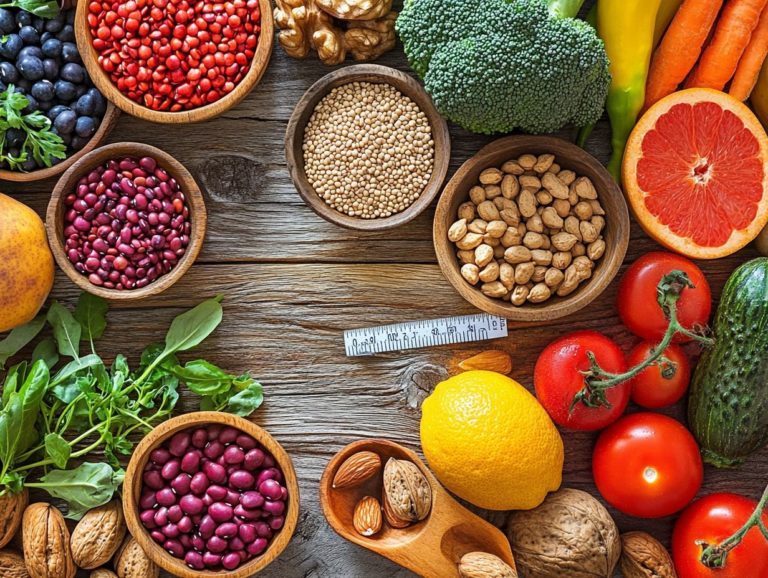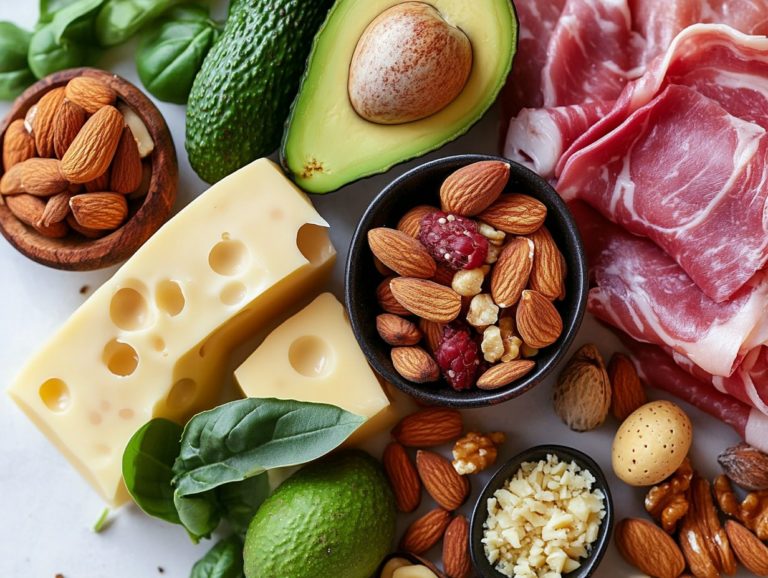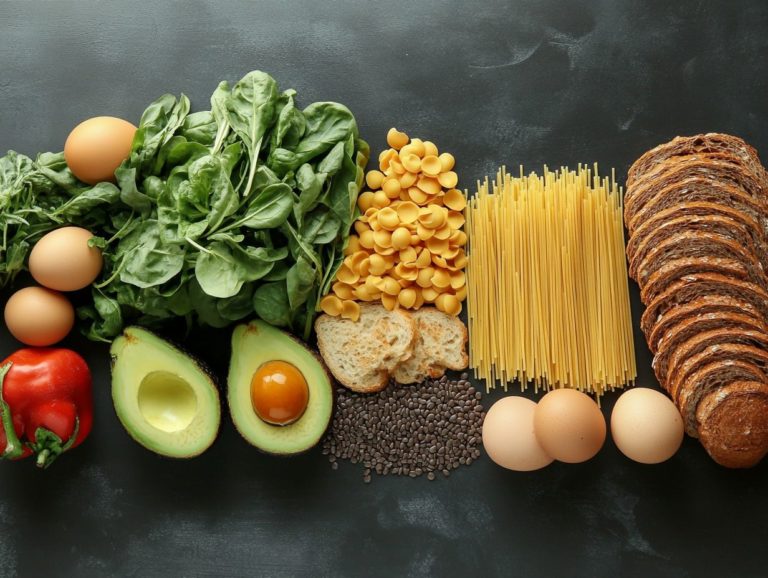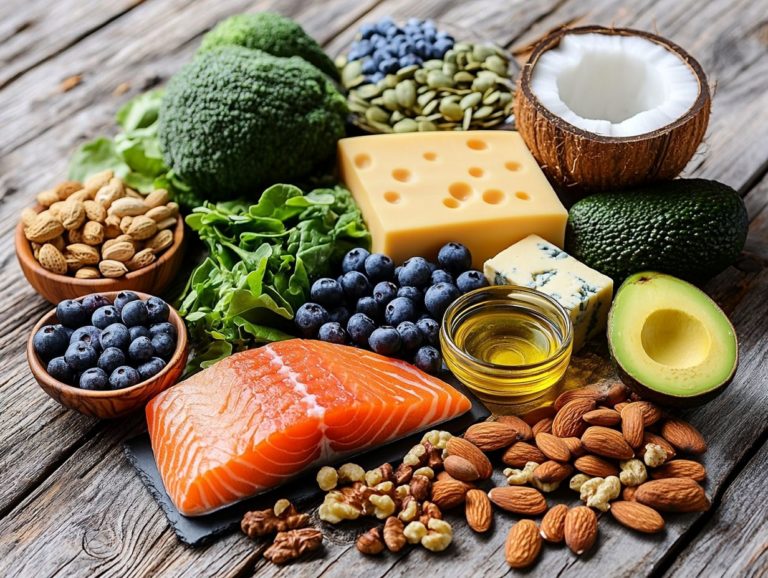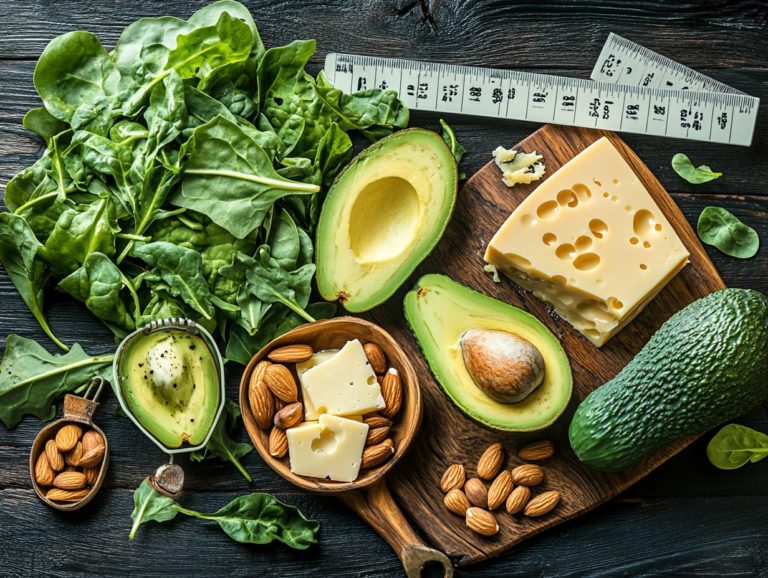How to Make Keto Nutritional Choices
Curious about the Keto diet? Let’s explore how this exciting approach can transform your health!
The Keto diet has surged in popularity as a potent strategy for weight loss and enhanced health. But what does this low-carb, high-fat diet truly involve?
This article delves into the essentials of the Keto diet, covering allowed foods, macronutrient ratios, and what you should steer clear of. You’ll gain insights into making informed nutritional choices, uncover delightful Keto-friendly meal ideas, and learn how to decipher nutrition labels with ease. This article also highlights the importance of maintaining a balanced diet for overall health.
Potential benefits and risks associated with this lifestyle are thoroughly examined, offering you a comprehensive guide to navigate your Keto journey, considering aspects of diet culture and restrictive diets. Whether you’re just embarking on your Keto adventure or seeking to refine your approach, this article caters to your needs, including tips on Keto meal plans and easy Keto dinners.
Contents
- Key Takeaways:
- What is the Keto Diet?
- What Foods are Allowed on the Keto Diet?
- What are the Macronutrient Ratios for the Keto Diet?
- What Foods Should be Limited or Avoided on the Keto Diet?
- How to Make Keto Nutritional Choices?
- Keto-Friendly Meal Ideas
- How to Make Keto-Friendly Substitutions?
- What Are the Potential Benefits of the Ketogenic Diet?
- What Are the Potential Risks of the Keto Diet and Other Restrictive Diets?
- Frequently Asked Questions
- Keto Nutritional Choices
- Are there any specific foods that I should focus on when making keto nutritional choices?
- How can I incorporate keto nutritional choices into my daily meals?
- Can I still eat out and make keto nutritional choices?
- Are there any potential downsides to making keto nutritional choices?
- What are some tips for staying on track with keto nutritional choices?
Key Takeaways:

- Make smart food choices by following the macronutrient ratios for the Keto diet: high fat, moderate protein, and low carbohydrates.
- Be mindful of hidden carbs by reading nutrition labels and making keto-friendly substitutions in meals.
- The Keto diet may have potential benefits such as weight loss, improved blood sugar control, reduced inflammation, and increased energy and mental clarity. However, it also comes with potential risks like nutrient deficiencies, difficulty sustaining long-term, and keto flu.
What is the Keto Diet?
According to Stefani Sassos of the Good Housekeeping Institute, the Keto diet is a low-carb, high-fat diet that has been shown to help with weight loss and overall health.
The Keto diet, often referred to as the ketogenic diet, is a low-carb, high-fat eating style crafted to transition your body into a state of ketosis. In ketosis, your body burns fat for energy instead of sugar from carbs.
This approach focuses on structured meals that prioritize nutritious ingredients, allowing you to experience significant weight loss while enhancing your overall health. Originally developed to tackle various health concerns, including diabetes, epilepsy, and heart disease, the Keto diet offers potential long-term benefits.
However, it s crucial for you to consult with a primary care provider before making any drastic changes to your dietary habits, as it’s important to consider your nutritional needs.
What Foods are Allowed on the Keto Diet?
The Keto diet can include a variety of healthy items such as low-carb veggies, plain Greek yogurt, and chicken thighs.
On the keto diet, you can relish a diverse array of keto-friendly foods that perfectly align with dietary guidelines. Picture low-carb vegetables, succulent protein sources like chicken thighs, and rich high-fat dairy products such as plain Greek yogurt. These foods not only support ketosis but also contribute to good overall health.
These carefully selected foods not only support a healthy eating pattern conducive to achieving ketosis, but also provide essential nutrients that contribute to your overall health and wellness. Embracing this approach allows you to enjoy delicious meals while nurturing your body.
For example, consider trying a keto-friendly stir-fry with low-carb veggies and chicken or a delightful breakfast of scrambled eggs with avocado. Variety is key to keeping your meals exciting and nutritious!
Ready to embrace the Keto lifestyle? Explore delicious Keto recipes and consider consulting a nutritionist to help tailor your diet to your needs!
What are the Macronutrient Ratios for the Keto Diet?
The macronutrient ratios for the keto diet are quite striking. Typically, you need to significantly increase your fat intake to about 70-75% of your total caloric consumption. Meanwhile, carbohydrates are kept to a bare minimum, around 5-10%, with proteins filling in the remaining 20-25%. These carefully curated ratios are intended to help you enter into ketosis, allowing your body to efficiently burn fat for energy. This can lead to noteworthy weight loss and enhanced metabolic health.
Grasping these ratios is essential for anyone eager to embrace this dietary lifestyle. They directly influence how your body utilizes nutrients and produces energy. When executed properly, the keto diet not only supports weight management but also enhances mental clarity and focus. This is thanks to the stable energy derived from fat sources.
Imagine a day’s meal plan that includes creamy avocado and eggs for breakfast, a vibrant salad drizzled with olive oil and topped with grilled chicken for lunch, and a sumptuous dinner featuring salmon with saut ed spinach all while maintaining that all-important macronutrient balance.
By prioritizing these macronutrient ratios, you are not just working towards a more favorable body composition; you may also enjoy added benefits like reduced inflammation and improved heart health.
What Foods Should be Limited or Avoided on the Keto Diet?
It’s essential to be cautious about certain high-carb foods that can sabotage your keto journey.
To successfully navigate the keto diet, you must limit or entirely avoid certain foods. This includes steering clear of processed meats, high-carb foods, sweetened yogurt, and refined sugars. These culprits can significantly spike your carbohydrate intake, preventing your body from using fat as its primary energy source. This can ultimately hinder your weight loss goals and overall health. Avoid sweeteners and sugar substitutes as well.
Watch out for starchy vegetables like potatoes and corn, along with various types of bread and pasta. These can create roadblocks for anyone dedicated to maintaining a low-carb intake. Consuming these foods can lead to spikes in blood sugar levels, pushing your body out of a fat-burning state and complicating your weight loss efforts.
Instead, consider opting for nutrient-dense, keto-friendly vegetables like spinach, cauliflower, and zucchini. Replacing sweetened yogurt with plain Greek yogurt or unsweetened coconut yogurt can help you keep your carbohydrate levels in check while still enjoying delicious flavors and beneficial probiotics.
How to Make Keto Nutritional Choices?
Maintaining a healthy lifestyle is vital for your success on the keto diet. Focus on healthful fats, such as olive oil and avocado oil, to support your overall health.
Making keto nutritional choices means understanding which foods align with ketogenic principles and carefully planning your meals within the framework of a low-carb, high-fat eating style. This approach demands thoughtful meal preparation and a keen awareness of food groups including cooking oils like olive oil and heart-healthy fats.
You might even consider consulting with a dietitian to ensure your nutritional needs are fully met while staying true to the keto guidelines.
In conclusion, sticking to the keto diet guidelines is crucial for achieving better health outcomes and maintaining a successful lifestyle change.
Keto-Friendly Meal Ideas
What Are Some Keto-Friendly Meal Ideas?

Keto-friendly meal ideas offer a delightful array of options. They make sticking to the diet manageable and truly enjoyable.
Picture yourself savoring a slice of savory pizza crafted from a cauliflower rice crust or relishing plain Greek yogurt topped with succulent berries. These meals encourage ketosis and align seamlessly with a healthy eating lifestyle.
To elevate your cooking experience, start breakfast with creamy avocado and bacon omelets. For lunch, enjoy flavorful chicken salads drizzled with a tangy olive oil and lemon dressing.
Dinner time is exciting with easy keto options like zucchini noodles tossed in pesto or baked salmon accompanied by asparagus. These meals align with a healthy eating style.
For those smart snacking moments, keep in mind these delightful choices:
- Almonds
- Cheese crisps
- Celery sticks paired with almond butter
Each meal type tantalizes your taste buds while fueling your body with essential nutrients like healthy fats and proteins. This helps maintain steady energy levels throughout the day. With these ideas, meal prep becomes a simple and enjoyable part of your routine.
How to Read Nutrition Labels for Keto?
Nutrition labels can help you make informed choices and avoid foods that may hinder your progress, especially if you are managing conditions like diabetes or heart disease.
Reading nutrition labels is key for anyone on the keto diet. It ensures your food choices fit within your carb intake goals. Pay close attention to total carbohydrates, net carbs, and the presence of sugar substitutes.
This practice is vital for maintaining a healthy lifestyle while avoiding hidden sugars and unnecessary carbohydrates. Be cautious about artificial ingredients and preservatives.
By carefully examining the nutrition label, you can identify critical elements like serving size, dietary fiber, and added sugars each of which plays a vital role in how a food item impacts your daily carb limits.
When on a ketogenic plan, it’s crucial to differentiate between total carbohydrates and net carbs, as net carbs truly influence your blood sugar levels and the state of ketosis.
If you’re adhering to specific dietary patterns, be vigilant about ingredients that could cause inflammation or disrupt digestion. Keep an eye on your intake of artificial ingredients and preservatives.
Understanding these components enables you to make informed decisions and strengthens your commitment to healthier eating habits.
How to Make Keto-Friendly Substitutions?
Explore keto-friendly substitutions in your recipes to maintain a low-carb intake. For example, use almond flour instead of regular flour.
Making keto-friendly substitutions is essential for your low-carb, high-fat diet. By swapping high-carb ingredients for low-carb alternatives, you can enjoy your favorite dishes.
Consider using almond flour or healthy fats like olive oil in your cooking. This approach ensures your meals remain nutritious and aligned with keto principles.
These thoughtful substitutions enhance your meals’ nutritional profile while keeping the flavor and texture delightful. Coconut flour is an excellent choice for baking as it offers a moist texture and mildly sweet flavor.
Switching to avocado oil can elevate your dishes’ health benefits. It’s rich in heart-healthy fats and great for saut ing or frying, supporting overall health.
Incorporate these alternatives into your cooking for delicious and satisfying meals without compromising your dietary goals. Low-carb veggies and plain Greek yogurt can both support your journey toward healthier eating.
What Are the Potential Benefits of the Ketogenic Diet?
The potential benefits of the keto diet are impressive. You can experience significant weight loss, improved blood sugar control, reduced inflammation, and boosted energy, all while enjoying enhanced mental clarity.
These remarkable advantages make the ketogenic diet an enticing choice for anyone seeking a healthier lifestyle. Following a structured meal plan with easy keto dinners can simplify managing your diet.
1. Weight Loss and Healthy Eating
One celebrated benefit of the keto diet is weight loss. Your body enters a state called ketosis, where it burns fat for energy instead of carbohydrates.
This shift leads to reduced body fat and weight. Focus on keto meal plans to meet your nutritional needs while pursuing your weight loss goals.
In ketosis, your liver converts fat into ketones, serving as a primary fuel source. Research shows that individuals on a keto diet can lose up to 10 pounds within the first month, which captivates many.
Support your transition with protein-rich options like chicken thighs and plain Greek yogurt. This method not only helps shed pounds but also increases satiety, making it easier to resist overeating.
Nutritionists highlight that the diet’s focus on high-fat foods can significantly lower insulin levels and enhance fat metabolism. High-fat dairy items like plain Greek yogurt and cheese boost fat intake.
Many personal testimonials frequently mention improved energy levels and mental clarity, adding to the appeal of this effective weight management strategy.
2. Improved Blood Sugar Control and Overall Health
One potential benefit of the keto diet that you might find particularly appealing is its ability to improve blood sugar control. This can be especially advantageous for individuals with diabetes, as the diet helps regulate insulin levels and reduces those pesky spikes in blood sugar.
By adopting this healthy eating pattern, you can also reduce your risk of heart disease. By significantly cutting down on carbohydrates, the keto diet encourages your body to enter a state of ketosis, where it starts burning fats for energy instead of sugars.
This shift not only enhances how well your body responds to insulin but also stabilizes your energy levels throughout the day. As a result, you ll likely discover thrilling improvements in your energy levels, experiencing fewer cravings and reduced overall hunger, which can contribute to improved metabolic health.
Research indicates that this diet may offer neuroprotective benefits, making it a fascinating area of study in relation to conditions like Alzheimer s, Autism, and Epilepsy, where stable blood sugar is vital for optimal brain function. The Epilepsy Foundation has endorsed the ketogenic diet as a therapeutic option for managing seizure disorders.
3. Reduced Inflammation and Long-Term Health
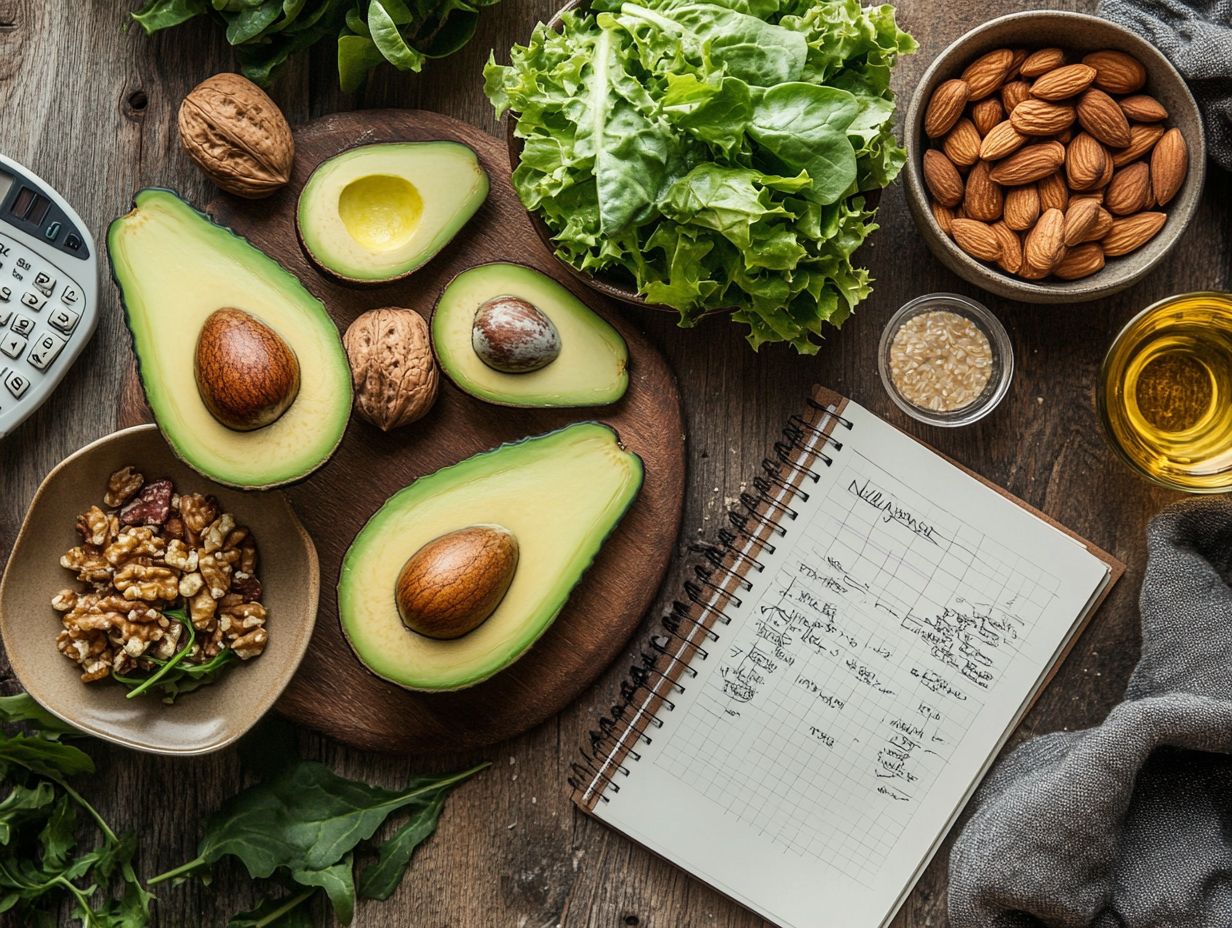
The keto diet can be your ally in reducing inflammation in the body, which is often linked to various chronic diseases and health concerns. By embracing this dietary approach, you promote a healthier lifestyle and enhance your overall well-being.
Consistently opting for healthy items like leafy greens and cooking oils such as olive oil can further support your anti-inflammatory goals. Research reveals that entering a state of ketosis can lead to lower levels of inflammatory markers, including C-reactive protein (CRP) and interleukin-6 (IL-6).
In fact, a study published in the journal “Nutrition and Metabolism” found that participants following a ketogenic diet experienced significant reductions in these markers after just 24 weeks.
Experts suggest that the diet s emphasis on healthy fats while restricting carbohydrates can shift your body’s metabolism, improving insulin sensitivity and potentially lowering the risk of conditions such as diabetes. Therefore, by adopting the keto diet, you may not only achieve weight loss but also experience notable improvements in your inflammatory responses, all supporting your long-term health objectives.
4. Increased Energy and Mental Clarity Through Healthy Eating
You may find that many individuals report increased energy levels and improved mental clarity as a benefit of adopting the keto diet. This boost could be attributed to the brain’s preference for using ketones as fuel instead of glucose, enhancing cognitive function.
Incorporating sugar substitutes can also help maintain this mental clarity by avoiding sugar spikes. This metabolic shift provides a more stable source of energy and minimizes the brain’s exposure to sugar spikes, enhancing your concentration and focus.
Research suggests that ketones can improve mitochondrial efficiency, leading to superior energy production in brain cells. Testimonials from users indicate that after making these dietary changes, they experienced sharper memory and quicker decision-making abilities.
Nutrition and mental health experts advocate for the ketogenic approach, highlighting its potential to support neuroprotective mechanisms, reduce the risk of neurodegenerative diseases, and ultimately foster a healthier brain environment.
This illustrates how thoughtful dietary choices can profoundly impact your cognitive well-being.
What Are the Potential Risks of the Keto Diet and Other Restrictive Diets?
While the keto diet presents a wealth of benefits, it’s crucial for you to weigh the potential risks that come with its adoption. These include the possibility of nutrient deficiencies, the challenge of maintaining the diet over the long term, and a phenomenon commonly known as the ‘keto flu’ that may arise during the initial adaptation phase.
Consulting a primary care provider or dietitian can help you navigate these risks effectively. Take charge of your health today by consulting with a nutrition expert!
Understanding Nutritional Deficiencies on the Keto Diet
One significant risk of the keto diet is the potential for nutrient deficiencies that may arise from restricting certain food groups. This highlights the importance of consulting a dietitian to maintain nutritional adequacy.
Staying updated with the latest health news and research is also important for making informed decisions. While you may relish the benefits of this low-carbohydrate lifestyle, you might overlook essential vitamins such as B vitamins and vitamin D, along with crucial minerals like magnesium and potassium.
To bridge these gaps, consider incorporating nutrient-dense foods like leafy greens, avocados, and nuts into your meals. Don’t hesitate to explore supplements when necessary. Consulting a primary care provider or dietitian can help you tailor your diet to meet your nutritional needs.
Adopting a balanced approach is vital. For example, opting for high-quality sources of fat, such as olive oil or fatty fish, not only provides energy but also delivers a rich array of nutrients. Avoiding processed meats and sugar alternatives can further contribute to your good overall health.
By taking these steps, you can appreciate the health advantages of the keto diet while safeguarding against potential deficiencies.
Difficulty Sustaining Long-Term
You might find it challenging to sustain the keto diet long-term due to its restrictive nature. This can lead to cravings for high-carb foods, jeopardizing the health benefits you’ve worked hard to achieve and tempting you to revert to previous eating habits.
To overcome these challenges, you can try gradually reintroducing carbohydrates. This approach allows you to enjoy moderate carb intake while maintaining your weight management goals. Strategies like cycling diets, where you alternate between periods of strict ketosis and higher-carb phases, can be effective.
This method satisfies cravings and reduces stress, making it easier to stick to your diet. Regular dietitian consultations can help you develop a sustainable and balanced eating plan.
By discovering a sustainable balance, you can foster a healthier relationship with food and significantly reduce the risk of slipping back into old dietary patterns. Engaging in regular meal prep sessions can also help you stay on track.
Keto Flu
The term ‘keto flu’ refers to the flu-like symptoms you might encounter during the initial adaptation phase of the keto diet, as your body shifts from burning carbohydrates to fats for energy.
This transitional phase can bring about discomforts such as headaches, fatigue, irritability, and muscle cramps. These symptoms occur as your body starts to deplete its energy reserves and enters ketosis, leading to fluctuations in electrolyte levels.
To ease these discomforts, it’s crucial to focus on hydration and maintain a balanced intake of electrolytes, including sodium, potassium, and magnesium.
Instead of abruptly cutting carbohydrates, consider gradually reducing your intake to help your body adjust more smoothly. Incorporating nutrient-dense foods and ensuring you’re consuming enough overall calories can further facilitate this shift into a ketogenic lifestyle, making the transition more manageable.
For more keto recipes and easy keto dinners, following channels like those by Stefani Sassos from the Good Housekeeping Institute can provide valuable tips and inspiration.
Frequently Asked Questions

What is the keto diet and why should I consider making keto nutritional choices?
The keto diet is a low-carb, high-fat, and moderate-protein eating plan that has numerous health benefits such as weight loss, improved blood sugar control, and increased energy. Making keto nutritional choices can help you achieve these benefits and improve your overall health.
Consulting with a primary care provider for a tailored keto meal plan can ensure that you meet all your nutritional needs.
Ready to embrace the keto diet? Start your journey today!
Keto Nutritional Choices
Are there any specific foods that I should focus on when making keto nutritional choices?
Yes, the keto diet focuses on consuming high-fat foods such as avocados, nuts, and seeds. It also includes fatty cuts of meat and healthy oils like coconut and olive oil.
Moderate amounts of protein from sources such as fish, poultry, and eggs are included as well. Low-carb vegetables like leafy greens, broccoli, and cauliflower are also encouraged.
Incorporating foods that fit the keto diet like plain Greek yogurt can diversify your meals and enhance your overall health.
How can I incorporate keto nutritional choices into my daily meals?
One easy way to incorporate keto nutritional choices into your daily meals is to replace high-carb foods like bread, pasta, and rice with low-carb alternatives like zucchini noodles, cauliflower rice, and almond flour.
You can also add healthy fats to your meals, such as avocado slices, olive oil drizzles, and a handful of nuts or seeds. This makes every meal more satisfying and delicious!
Can I still eat out and make keto nutritional choices?
You can absolutely enjoy eating out while sticking to your keto goals! Many restaurants offer keto-friendly options such as salads with added protein, bunless burgers, and grilled meats with low-carb vegetable sides.
You can also ask for substitutes, like extra veggies instead of potatoes or fries, ensuring you stay on track while enjoying dining out.
Are there any potential downsides to making keto nutritional choices?
While there are many benefits to making keto nutritional choices, it is important to note that this diet is not suitable for everyone. Those with certain medical conditions, such as diabetes or kidney disease, should consult with their doctor before starting the keto diet.
Some people may experience side effects such as the “keto flu” during the first few days of transitioning to this way of eating, so be aware and prepared!
What are some tips for staying on track with keto nutritional choices?
Don t wait! Start stocking your kitchen with keto-friendly foods today!
Planning and preparation are key to staying on track with keto nutritional choices. Meal prep ahead of time and have keto snacks on hand for when cravings strike.
Tracking your macros (fat, protein, and carb intake) using a food diary or app can also help you stay within the recommended ranges for the keto diet.


